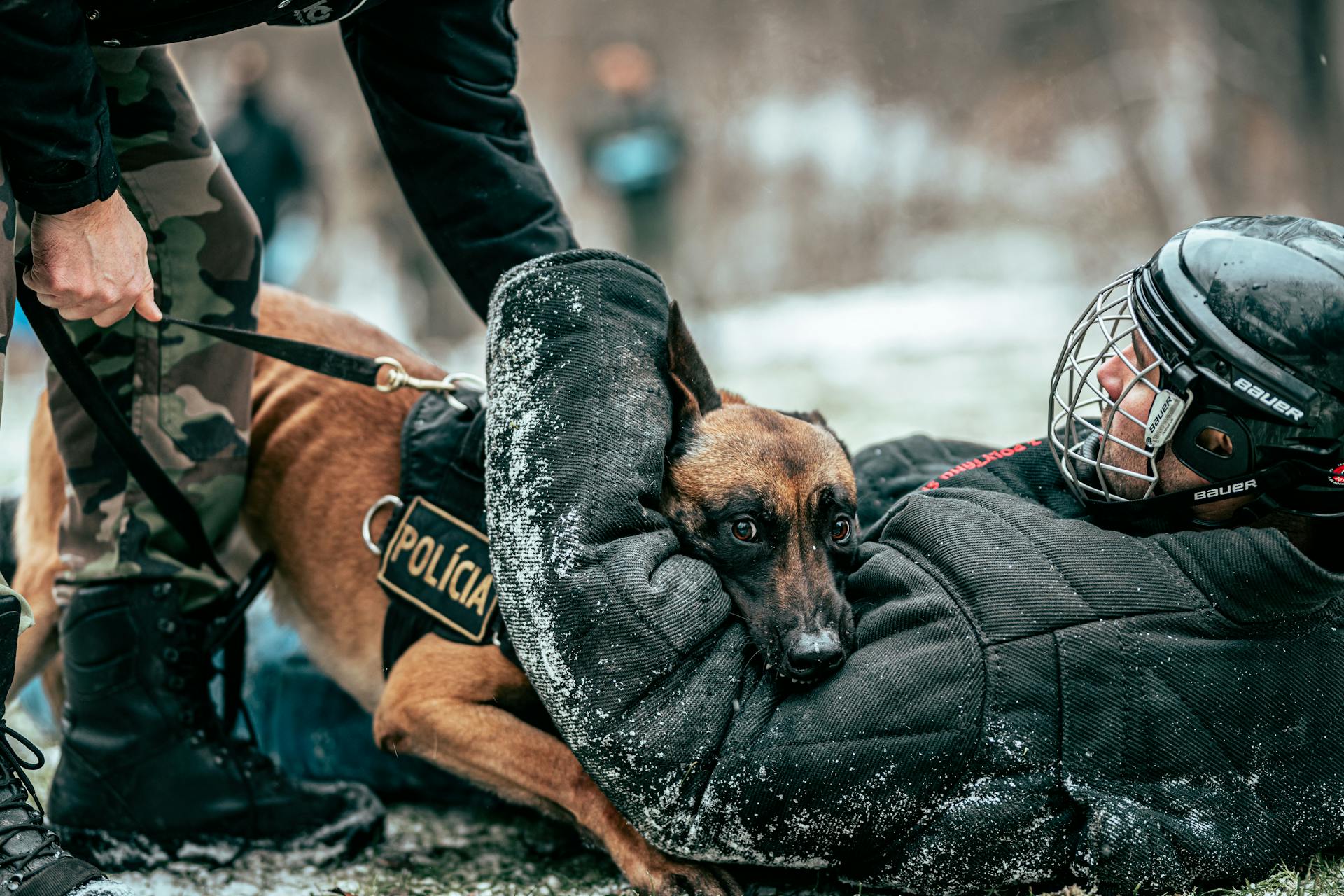
FFR+ dog training is a positive approach to training your furry friend, focusing on rewarding desired behaviors rather than punishing undesired ones.
This approach is based on the principles of operant conditioning, which states that behavior is shaped by its consequences. By associating desired behaviors with rewards, you can encourage your dog to repeat those behaviors.
A key aspect of FFR+ training is the use of clear and consistent communication with your dog. This means using a calm and assertive tone of voice, and being specific with your commands and rewards.
Consistency is crucial in FFR+ training, as it helps your dog understand what behavior is being rewarded and what's expected of them.
Training Methods
Positive reinforcement is the best way to train your dog. It focuses on giving your canine something they want or desire, such as a favorite toy or treat, which acts as a driver to ensure the pup continues to repeat the task or behavior to gain the reward.
Reprimanding your dog during the training process only causes the uncertain emotions of the dog to escalate. This can lead to a snowball effect, building a dog's insecurities and causing bad behavior to take hold and become even more of a problem.
Force-free training provides the best results when dealing with an uncertain or fearful canine. By understanding your dog's emotions and implementing respondent conditioning play sessions, you can change your dog's emotional balance from negative to positive, making them feel calm, happy, and more focused.
Simple tasks like treat training are a great way to teach your dog good behavior. Start small, and work up to more challenging behaviors.
Force-free dog training can be used to help correct some of the most common behavioral concerns in dogs, such as stopping a dog from pulling, leash aggression, recall training, and more.
Here are some simple lessons you can start with to help you build a trusting bond with your dog:
- Stop a dog from pulling
- Leash aggression in dogs
- Recall training in dogs
- Stop a dog from jumping on people
- Stop a dog from digging
The possibilities are endless with the right techniques, and you can teach your dog good doggy behaviors and some cool party tricks.
Preparation and Guidance
To prepare for your first dog training class, look for and reward positive behaviors in your dog while correcting and praising them for potty training. This will foster polite behavior and strengthen the bond at home.
Punishing a dog verbally or physically not only damages the bond between a dog and its owner, but it causes the dog to avoid doing those behaviors in front of the owner. It doesn't teach the correct behavior and without teaching correct behavior, your dog will continue to make mistakes.
You can implement the Learn to Earn Rule by asking your dog to perform tasks in exchange for what they desire, like sitting before meals or greeting guests.
A fresh viewpoint: Begin the Bond Dog Training
What Training Can Do for You
Force-free dog training can help you teach your dog good behavior and correct common behavioral concerns. It's a great way to build a trusting bond with your dog.
You may already be using force-free dog training methods without realizing it. Simple tasks like treat training can be a great starting point. Start small and work your way up to more challenging behaviors.
Additional reading: What Is Force Free Dog Training
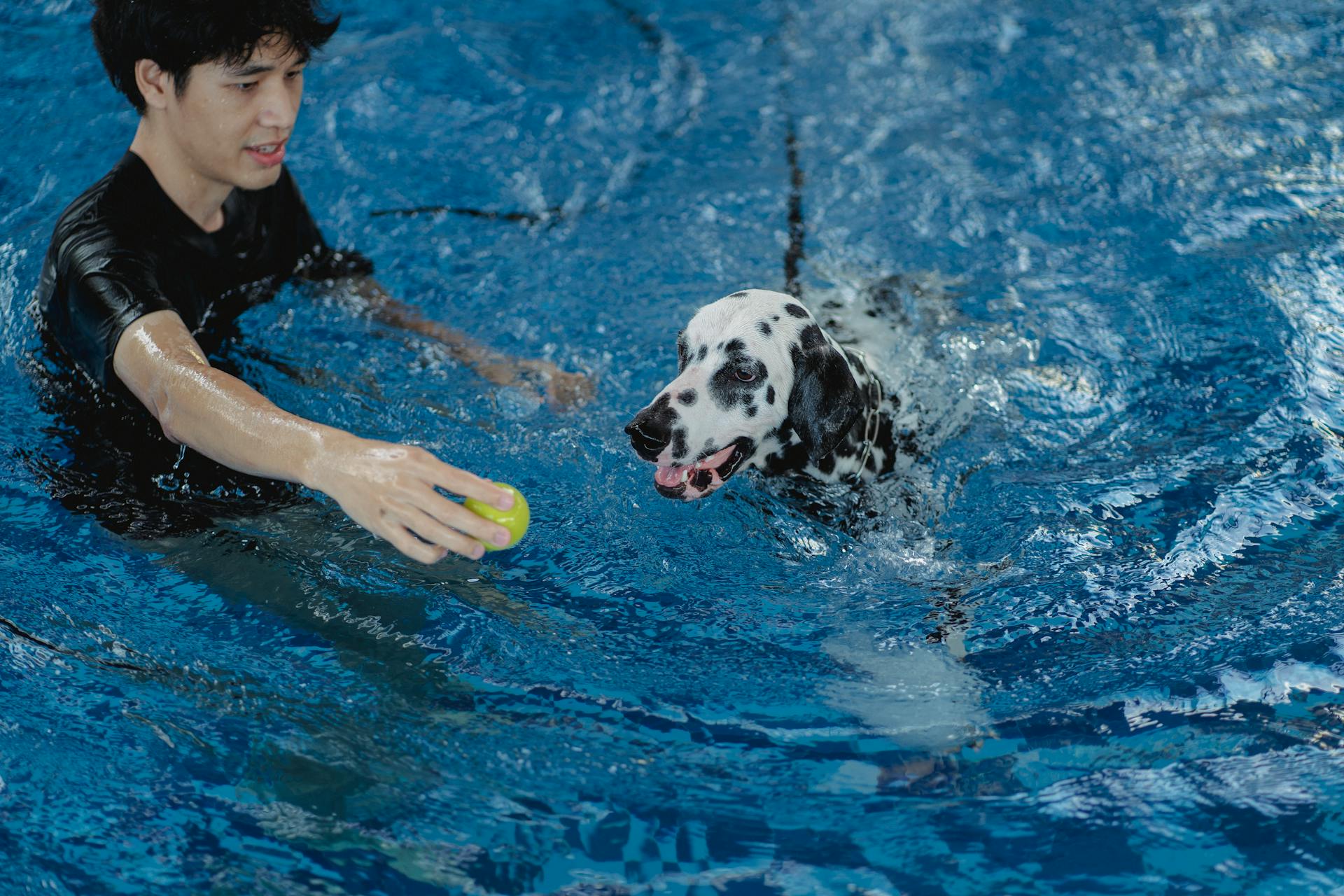
Force-free dog training can help with various issues, including stopping a dog from pulling on the leash, leash aggression, recall training, and more. With the right techniques, you can teach your dog good doggy behaviors and even some cool party tricks.
Here are some simple lessons you can start with to help you build a trusting bond with your dog:
- Treat training
- Leash training
- Recall training
- Basic obedience commands
If you're unsure about how to proceed, working with a professional trainer can be a great option. They can help you and your dog overcome challenges and achieve your training goals more efficiently.
What to Prepare for First Class?
As you prepare for your first dog training class, it's essential to establish a positive relationship with your dog. Punishing your dog verbally or physically damages the bond between you and your dog.
To foster polite behavior and strengthen your bond at home, implement the Learn to Earn Rule by asking your dog to perform tasks in exchange for what they desire, such as sitting before meals or greeting guests.
You might enjoy: Unbreakable Bond Dog Training
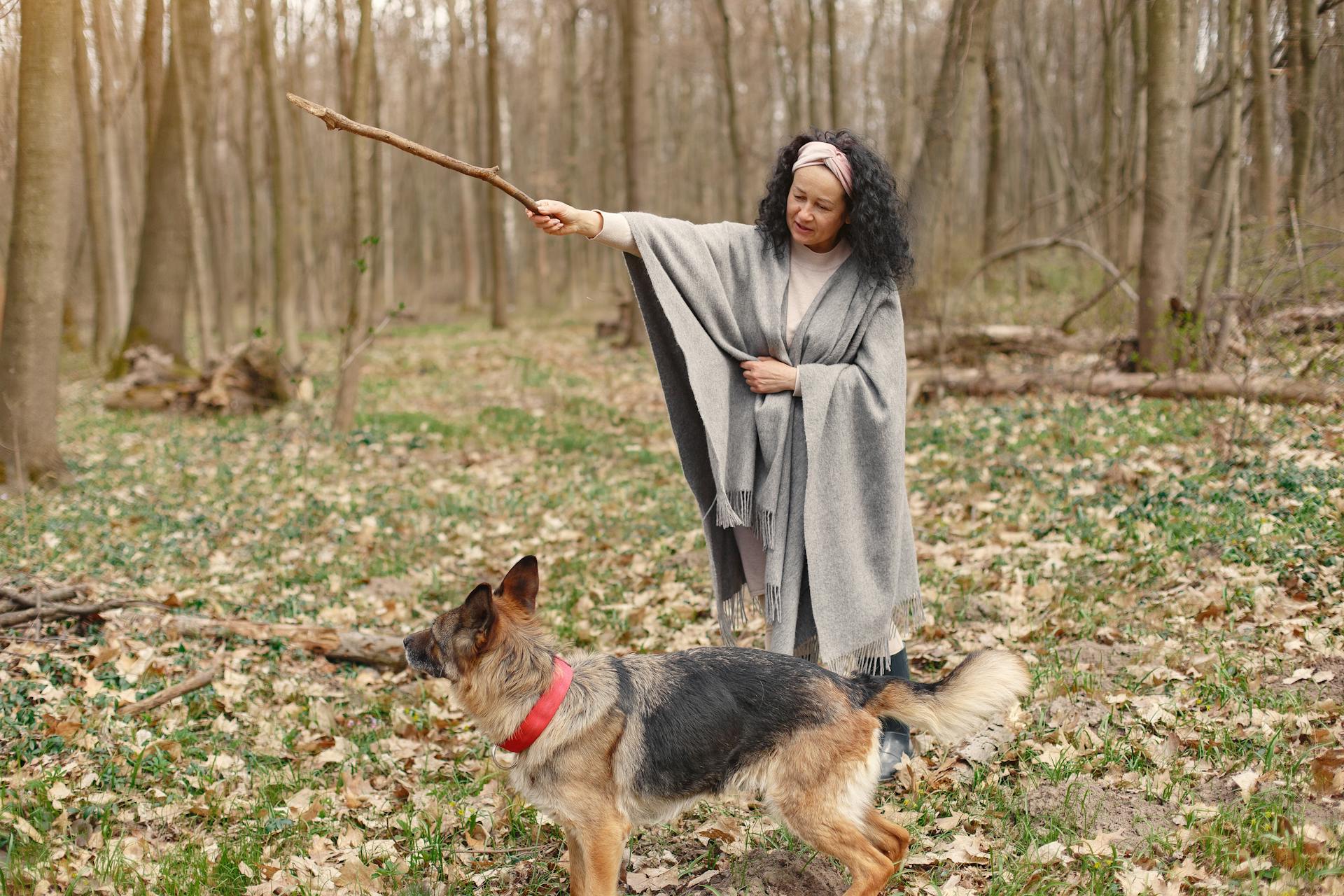
Look for and reward positive behaviors in your dog while correcting them for potty training. This approach will help your dog learn correct behavior and avoid making mistakes.
By doing so, you'll set the stage for a successful first class and a lifelong learning experience for both you and your dog.
Home vs Professional Guidance
Force-free training techniques can be used at home for basic obedience training, but for more complex issues, consulting with a professional force-free trainer is often beneficial.
You can start with simple exercises at home, but if you're struggling to get results or if your dog has specific needs, it's best to seek professional guidance.
A professional trainer can help you address complex issues and provide personalized advice and support throughout the training process.
Researching a trainer's credentials and experience is crucial to ensure you're working with a qualified professional.
Look for a trainer with certifications like those mentioned in the article, which indicate they have the proper training and expertise.
Don't be afraid to ask questions or seek help if you're unsure about any aspect of the training process.
A different take: Training to Be a Guide Dog Trainer
What to Expect from Our Services?

Our services are designed to provide you with effective and lasting dog training using force-free techniques. We have certified trainers experienced in various cases who will work with you and your dog to achieve the best results.
You can expect small class sizes to ensure more individualized attention, and we also offer one-on-one sessions, including in-home training. This personalized approach will help you build a trusting bond with your dog.
We use a variety of techniques, such as clicker training, treat training, target training, and leash training, to teach your pup the skills they need to be a well-mannered canine. These techniques are based on positive reinforcement, consistency, and patience.
Here are some of the common behavioral concerns we can help with:
- Stopping a dog from pulling on the leash
- Addressing leash aggression in dogs
- Teaching recall training in dogs
- Stopping a dog from jumping on people
- Stopping a dog from digging
By working with a certified trainer, you can get started on the right foot and receive valuable advice and support throughout the process.
Getting Started with R+
R+ is the core concept of force-free dog training, and it's all about using positive reinforcement techniques to teach your dog good behavior. Positive reinforcement is the process of adding a desired stimulus or reward to encourage desired behavior.
Worth a look: What Is Positive Reinforcement Dog Training
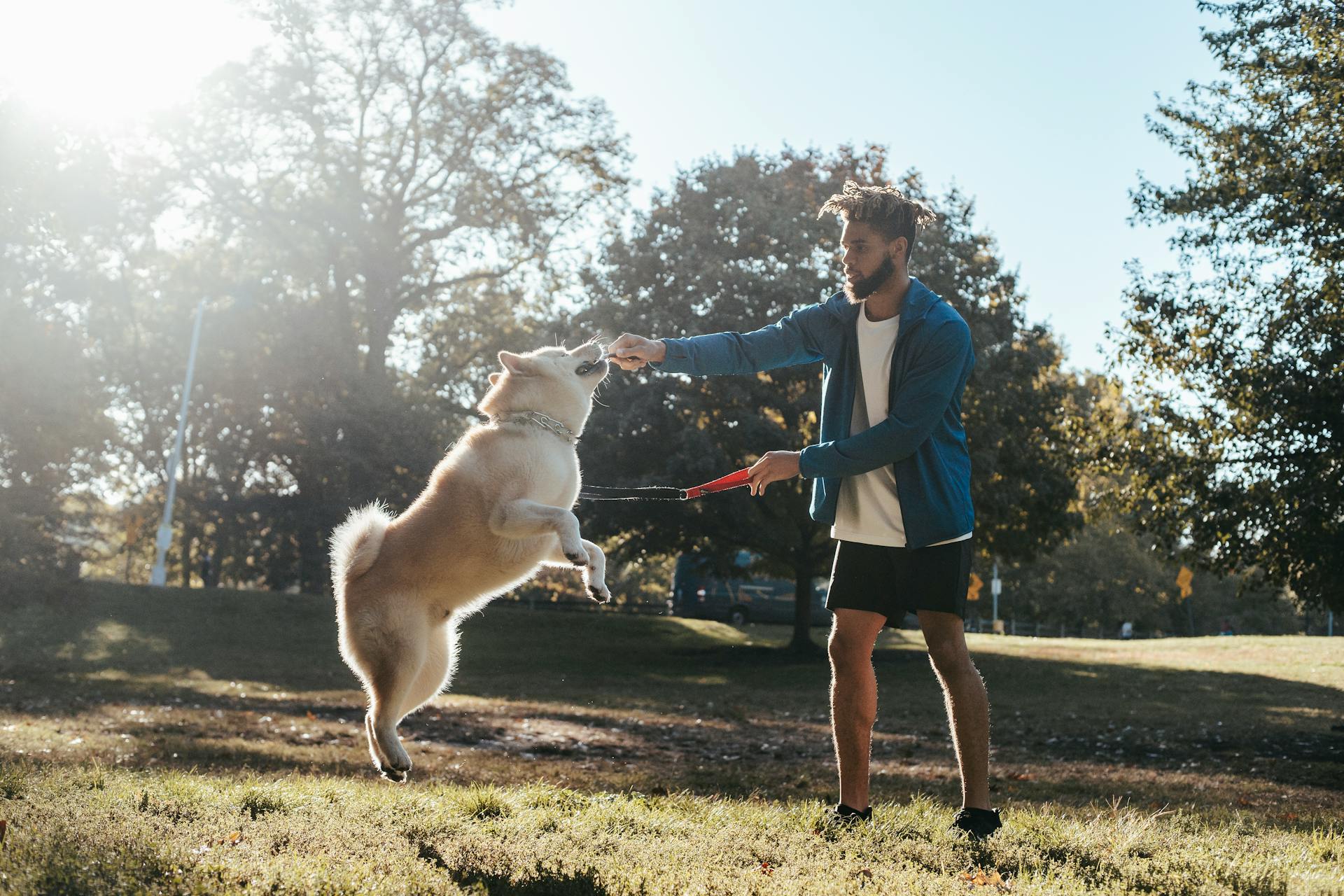
You can start using R+ in simple tasks like treat training, which is a great way to teach your dog to sit, stay, and come when called. Treat training is a form of R+, where you ask your dog to perform a task and reward them with a treat or praise.
To get started with R+, you'll need to identify what motivates your dog and use that to your advantage. If your dog loves treats, use treats as rewards. If your dog loves praise, use praise as rewards.
Here are some simple lessons you can start with to help you build a trusting bond with your dog:
- Start with short training sessions (5-10 minutes) to keep your dog engaged and focused.
- Use high-value rewards like treats, praise, and playtime to motivate your dog.
- Be consistent and clear in your commands and rewards.
- Gradually increase the difficulty of the tasks as your dog becomes more confident and skilled.
Remember, R+ is all about creating a positive and supportive learning environment for your dog. By using positive reinforcement techniques, you can teach your dog good behavior and build a strong, trusting bond with them.
Techniques and Tools
Clicker training is an effective technique for teaching dogs new behaviors, using a clicker to mark the desired behavior and rewarding it with a treat.
You might enjoy: Dog Training Clicker Training
Treat training is a simple and effective way to teach a dog new behaviors, rewarding the dog with a treat for performing the desired behavior.
Clicker and treat training share a common goal of associating a desired behavior with a reward, making learning a fun and engaging experience for dogs.
Here are some common techniques used in FFR+ dog training:
- Clicker training
- Treat training
- Target training
- Leash training
A Treat Pouch
A Treat Pouch is a must-have for any force-free dog trainer. It's a convenient way to keep your treats within easy reach, allowing you to reward your furry friend quickly and consistently.
You can use a Ziploc bag in your pocket, but a dedicated treat pouch is the best option. It's designed specifically for this purpose, making it easier to store and retrieve treats.
A treat pouch can hold a variety of treats, from kibble to hot dogs or cheese. This is especially helpful for picky eaters who require something special to keep them engaged.
If this caught your attention, see: It's Your Choice Dog Training
To get the most out of your treat pouch, make sure to stock up with a variety of treats. This will help keep your dog attentive and interested in the training process.
Here are some essential items to include in your treat pouch:
- Kibble
- Hot dogs
- Cheese
- Other favorite treats
Remember, a treat pouch is a valuable tool in any force-free dog trainer's arsenal. With it, you'll be able to reward your dog consistently and effectively, helping to build a strong bond and achieve desired behaviors.
A Harness
Harnesses are a good idea if your dog tends to choke themselves by pulling.
They can help prevent this from happening, which is especially important for dogs with narrow chests or those that are prone to pulling hard.
If you are not familiar with dog harnesses, ask your new trainer what style they would recommend for your dog.
This will help ensure you get the right fit and style for your dog's specific needs.
Some harnesses even come with additional features like padding and adjustable straps for added comfort and support.
Recommended read: Leash Training a Dog That Pulls
Challenges and Limitations
Force-free dog training requires more time and patience compared to punitive methods. It's a trade-off for the long-term benefits of a positive and trusting relationship with your dog.
Finding the right motivators for each individual dog can be a challenge. Every dog is unique, and what works for one dog may not work for another.
With force-free training, you need to be willing to invest time and effort into understanding your dog's needs and preferences. This can be a rewarding experience, but it does require a bit more work upfront.
Suggestion: Crate Training While at Work
Are There Challenges or Limitations?
Force-free dog training techniques require more time and patience compared to punitive methods. This is because they rely on finding the right motivators for each individual dog.
Punishment tools like shock collars and prong collars may offer a quick fix to problem behaviors, but they don't teach alternative behaviors.
Dogs can suffer from the constant stress of punishment, even if it's marketed as a gentle tickle.
Readers also liked: Negative Punishment Dog Training
Navigating Bad Advice
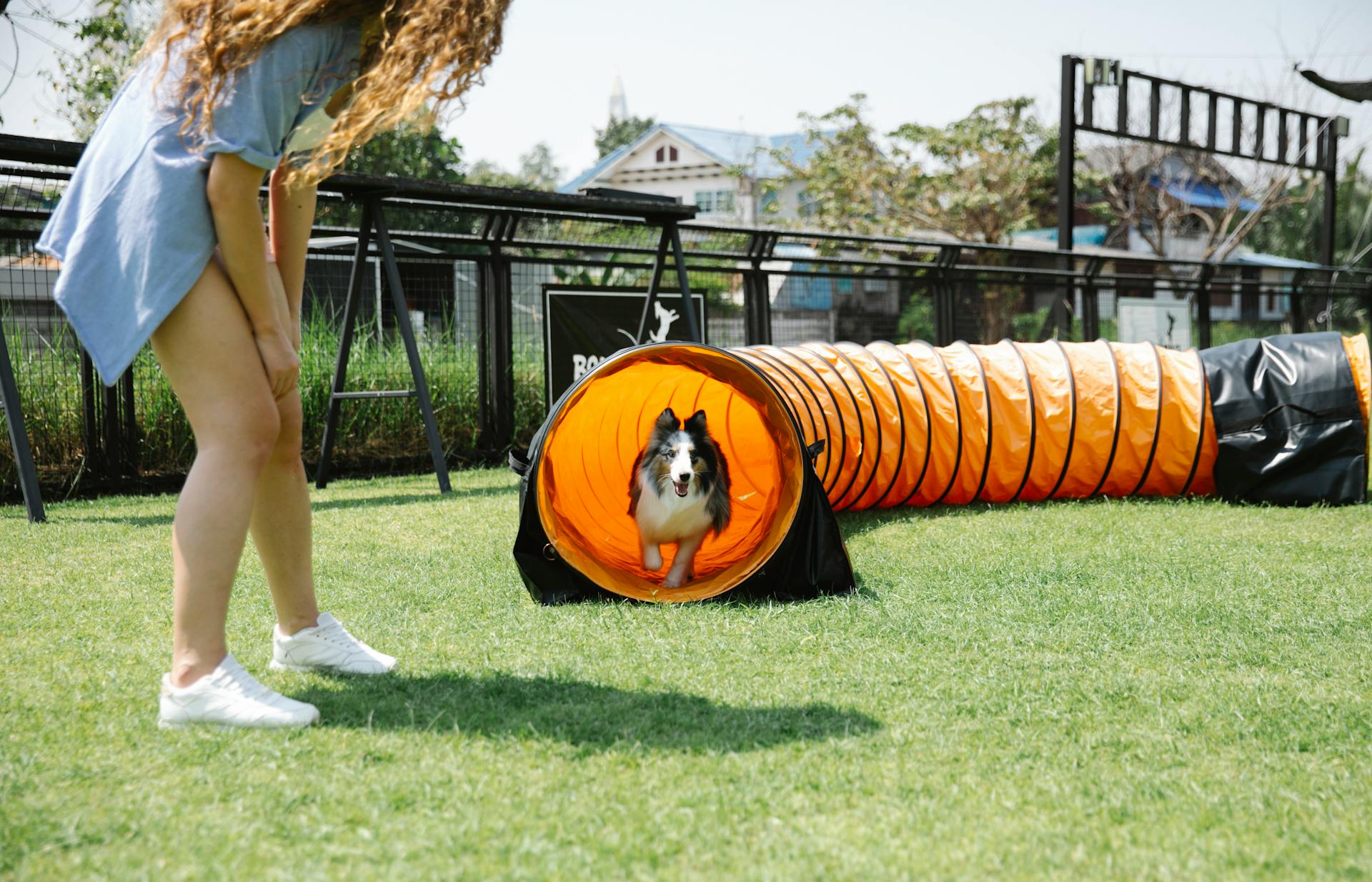
Navigating bad advice can be overwhelming, especially when it comes to pet training. There are many competing opinions and options available.
Searching online can lead to a string of trainers, courses, businesses, books, and more, making it difficult to weed through the information.
The author of this article has personally experienced the frustration of trying to find the best advice. They've searched for pet training methods, read self-help books, and looked at classes in their area.
The author defines the "best" advice as the method that is humane, successful, and backed by science.
Recommended read: Dog in Training Do Not Pet Vest
Force-Free Training
Force-free training is a science-backed method to encourage good behaviors in your pup and discourage or correct the bad ones. It's a humane approach that helps establish a healthy relationship between you and your pet.
Positive reinforcement is a key component of force-free training, where you give your dog something they want or desire in exchange for good behavior. This can be a favorite toy or treat, and it acts as a driver to ensure your dog continues to repeat the task or behavior to gain the reward.
Worth a look: Is Petco Dog Training Good
Simple tasks like treat training are a great way to teach your dog good behavior, and you can start small and work up to more challenging behaviors. Force-free dog training can be used to help correct common behavioral concerns in dogs, such as leash aggression, recall training, and jumping on people.
The possibilities are endless with force-free training, and you can teach your dog cool party tricks and good doggy behaviors. Here are some simple lessons you can start with to help you build a trusting bond with your dog:
- Stop a dog from pulling
- Correct leash aggression
- Teach recall training
- Stop a dog from jumping on people
- Stop a dog from digging
Force-free training is not the same as balanced training, which combines reinforcement with punishment. Balanced training can actually cause fearful or anxious responses from your dog, leading to a buildup of distrust between the dog and the handler.
Force-free training, on the other hand, focuses on creating good behavior in the canine through the use of positive reinforcement with dog treats or toys. You can even reward the dog with a fun activity that they enjoy, such as going for a walk after a job well done.
If the dog does not obey, then you walk away, which immediately lets the pup know you are displeased. With force-free training, the dog learns when they are exhibiting unwanted behavior through non-violent techniques.
For your interest: Training Dog to Walk beside You
Reinforcement Training
Reinforcement training is a key component of ff/r+ dog training. It's all about giving your dog something they want or desire, like a favorite toy or treat, to encourage good behavior.
The concept of positive reinforcement is science-based and effective. By using rewards, you form a solid bond with your dog and help them feel calm, happy, and more focused.
To use positive reinforcement, you can start with simple tasks like treat training. This involves asking your dog to sit, and rewarding them with a treat or praise when they do.
Here are some examples of using positive reinforcement to say "no" to unwanted behavior:
- If your dog won't drop their tug toy, they miss out on their treat.
- If your dog doesn't stay when asked, they miss out on their treat.
- If your dog refuses to sit before going outside, the door remains shut.
These examples illustrate how saying "no" doesn't have to involve punishment or force. Instead, using rewards as motivation is successful in setting expectations for your dog.
By using positive reinforcement, you can teach your dog good behavior and even some cool party tricks. Here are some simple lessons you can start with to help you build a trusting bond with your dog:
- Teach your dog to stop pulling on the leash
- Teach your dog to walk calmly on a leash
- Teach your dog to recall to you
- Teach your dog to stop jumping on people
- Teach your dog to stop digging
Remember, the possibilities are endless with positive reinforcement training!
Sources
- https://blog.homesalive.ca/dog-blog/force-free-dog-training-tips
- https://www.mindbodypaws.dog/blog/rplus-dog-training
- https://spectrum-canine.com/main/an-introduction-to-force-free-dog-training/
- https://pets.joinfluffy.com/pet-universe/post/dog/training/ff-r-dog-training
- https://medium.com/creatures/r-training-941db2ffcd2e
Featured Images: pexels.com


